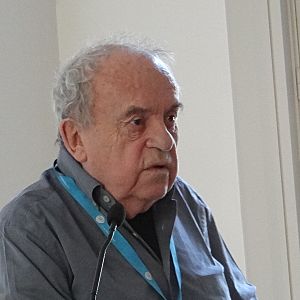Jean-Michel Savéant facts for kids
Quick facts for kids
Jean-Michel Savéant
|
|
|---|---|
 |
|
| Born | 19 September 1933 |
| Died | 16 August 2020 (aged 86) |
| Nationality | French |
| Awards | CNRS Silver Medal (1976) Member of the French Academy of Sciences (2000) Foreign Associate of the National Academy of Sciences (2001) |
| Scientific career | |
| Fields | Electrochemistry |
| Institutions | Paris Diderot University École Normale Supérieure University of Padua California Institute of Technology Cornell University |
Jean-Michel Savéant (born September 19, 1933 – died August 16, 2020) was a famous French chemist. He was an expert in electrochemistry, which is a special part of chemistry that studies how electricity and chemical reactions are connected. He was recognized for his important work by being chosen as a member of the French Academy of Sciences in 2000 and a foreign associate of the National Academy of Sciences in the United States in 2001. He wrote more than 400 scientific articles during his career.
Life and Career
Jean-Michel Savéant was born in Rennes, France. He finished his studies in 1958 and earned his PhD in 1966 from the École Normale Supérieure, which is a very well-known school in France.
In 1971, he moved to Paris Diderot University. There, he started a special laboratory called the Laboratoire d'Électrochimie Moléculaire. He became a professor of electrochemistry at this university. He was also an emeritus research director at the CNRS, which is France's national center for scientific research. He published over 500 scientific papers.
What is Molecular Electrochemistry?
Jean-Michel Savéant is known for creating and developing a new area of science called molecular electrochemistry. This field combines what we know about electricity and chemical reactions with the study of molecules.
Molecular electrochemistry helps scientists understand many different areas of chemistry and biology. For example, it helps us learn about:
- Electron transfer: How tiny particles called electrons move between molecules.
- Free radicals: These are very reactive molecules that play a role in many chemical processes.
- Chemical reactivity: Why and how chemicals react with each other.
- Catalysis: How some substances can speed up chemical reactions without being used up themselves. This is very important for solving modern energy problems, like creating new ways to produce clean energy.
Savéant's work helped connect electrochemistry to fields like photochemistry (how light affects chemical reactions) and enzymology (the study of enzymes, which are special proteins that help chemical reactions happen in living things).
Awards and Recognition
Jean-Michel Savéant received many awards for his important scientific work. Some of these include:
- Prix Louis Ancel de la Société Chimique de France (1966)
- Médaille d'argent du CNRS (CNRS Silver Medal) (1976)
- Faraday Medal of the Royal Society of Chemistry (1983)
- Prix Emile Jungfleisch of the Académie des Sciences (1989)
- Charles N. Reilley Award (1990)
- Olin Palladium Award of the Electrochemical Society (1993)
- Manuel Baizer Award of the Electrochemical Society (2002)
- Distinguished Fairchild Scholar at the California Institute of Technology (1988)
- Baker Lecturer at Cornell University (2002)
- Member of the Académie des Sciences (2000)
- Foreign Associate of the National Academy of Sciences of the United States of America (2001)
- Air Liquide Essential Molecules Challenge (2016)
See also
 In Spanish: Jean-Michel Savéant para niños
In Spanish: Jean-Michel Savéant para niños

